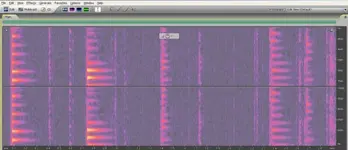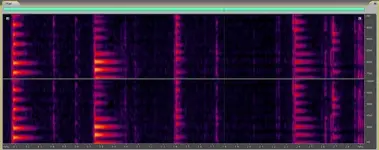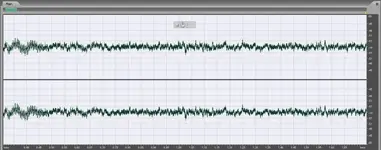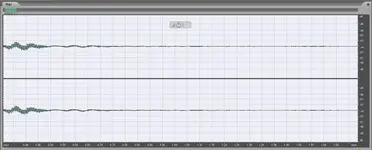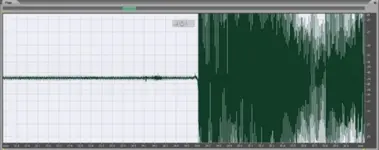Got a chance to listen to sample and while it can be difficult to tell for sure from a processed MP3 (while it might seem obvious just need to reiterate that for trying to trouble shoot the type of issue you raised with initial post a completely unprocessed, unedited raw 'wav' always tends to be more useful)
and what I hear is a noisy room, probably noisy mic, perhaps noisy pre. I'm not attempting to be excessively critical of the tools with which you have to work . . . those are the conditions audio recording has been dealing with from the very beginning and controling the issues is very much budget related
will attempt to post a couple of pics that illustrate (again taking into account that I'm working from a processed mp3) a bit of what I'm talking about. Two are plots of frequency over time with relative amplitude being suggested by color . . . warm colors (though green tends to be on beyond 0) suggesting higher amplitudes cooler colors lower. Two are amplitude over time just of the noise sample (for NR profile) @ beginning of the posted sample. One is quick contrasting 'test' from gear here.
The 'noise' is not just self noise. Lot of activity in what ever room you used to record. The more active transient even 'feels' like a reciprocating event . . . does not appear to show of periodically but door (even revolving door), some mechanical device starting or stopping, except that it doesn't repeat it almost 'felt' like a fan. Then there is a lot of general not quiet ambient stuff (smeared across the entire human audio spectrum), and finally even what seemed to be back ground conversation. How 'damaging' any of this is hard to tell from a processed sample. It shows up, in the sample around -50 dB . . . under relatively normal, background listening conditions for average US households it would be relatively inaudible. In studio through monitors set at levels I use for mixing (and I do not mix at particularly loud level) it was pretty obvious but not intrusive during the music. through same system but set for staring at the sky, drinking a cup of coffee contemplating the universe music in the background; level on even the noise sample alone was more or less inaudible (system level down somewhere around -24 dB).
the reasonably good news is that I don't think the primary noise source is bad grounds, bad power supply, ground loop, malfunctioning gear. Bad news is its the room, mic, mic-pre. Only things like the opening spike transient had regular, repeating, harmonics (starting way down @ 40 Hz). For a lot of electrical issues you will be able to identify a fundamental (usually not quite as obvious as the 60 cycle hum) with an identifiable harmonic sequence. That kind of thing is, by definition not 'noise' and certainly not white noise . . . but are unwanted artifacts . . . but what ever was in original I didn't see/hear electrically induced artifacts in the sample
In the frequency plot pictures the guitar transients will show as the yellow/red spikes, not all the stuff represented by the lavender 'dust' is unwanted noise (by any means) . . . much of it is simply the decay of the guitar note. Contrast between the first two pics is that first one is 'raw', second used 5 sec or so from sample prior to first note for a noise profile and then subtracted roughly 38% of that from the sample. there is no free lunch to NR, you will introduce artifacts by applying it . . . but at 38% (with other parameters set to control artifacts) I got a good compromise between getting rid of noise and not introducing anything objectionable. Pics 3 & 4 show about two seconds of the noise sample prior to NR and after applying NR @ 100%, respectively. Events like the initial transient are not particularly amenable to this sort of NR, and applying a profile with a lot that kind of spike will introduce artifacts in the content.
I have neither Samson C02 nor R16 but took another of the inexpensive Chinese SDCs (MXL I think), attached it to a
Zoom H4, then at the commercial studio I use (chauvinism suggests, to me, that project studio is quieter then room OP used but point was not to compare his noise to my noise, and project studio remains a typical project studio), which is . . . well, commercially 'quiet' . . . what you're seeing, amplitude over time is suggestion of 'self noise' of that system (it is not a rigorous test for 'self noise' . . . and even with that mic, that mic pre, that A/D I think I should be able to do better . . . but this was purely down and dirty . . . set gain via headphones on the Zoom hand held and it seemed OK. Finger picked guitar signal peaked about -13 dB, system noise is stuff on left hand side. Quiet room, not particularly quiet mic positioned about 9 in from body of guitar. The variables are pretty consistent no matter what pieces comprise the system: room, mic, mic-pre, recorder, A/D, interconnects . . . you juggle the pieces to pursue the sound you want. For example, in the 'test', if I turned down gain on pre, would Noise profile for subsequent NR introduce fewer artifacts when I'd boosted final signal to point where I wanted it? There is no one size answer fits all.
Sort of obviously better rooms (with grounded power) make a huge difference (in the 'test' in the squiggle on the left there is nothing significant from the room . . . Wish I'd thought to use a decent mic through studio stock pre's into their A/D . . . I doubt (certainly not through any standard mic) we'd see a noise floor down at -96 dB, let alone the potential -108 . . . but I'd be surprised if it was significantly higher then -80 (kind of down where you'd get with NR in the nosier room.
I quite honestly don't understand what OP is trying to relate concerning the listening in the car. In my experience if you try to amplify a signal in a car to over come ambient noise you are going to be deep into system self noise . . . perhaps correlated to content but not dependent on it in any way . . . nor, as far as I know is there any standard calibration that even suggests what '80' means for any given car amplifier . . .
To reiterate, from the sample I hear a fairly noisy environment in which to record. Nothing that suggests any quick fix, or defective gear. Even at noise level in the room working with position of performer and mics to performer can help. Again if I remember correctly the C02 had a pretty severe cardioid pattern . . . almost hyper cardioid . . . which might help with 'noise' off axis but presents an area of extended sensitivity on axis but to the rear of the mic . . . and by nature of beast (design and how mics work) that stuff, in a generalized noisy environment is actually going to be tougher to tame then artifacts from using a less severe cardioid or even an omni capsule. Again all, every single one, strategies (cardioid mics designed to reject off axis material) to tame the 'unwanted' in audio work best on material that needs them the least . . . hyper-cardioid mics perform better in quiet rooms then in noisy ones, etc.


